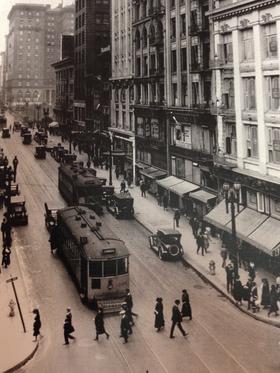This year, two Muni streetcars celebrate their centennials. Both were bought from the Jewett Car Company of Ohio in 1914 as part of an order of 125 streetcars to serve lines Muni was then building to serve the following year’s Panama-Pacific International Exposition.
These two streetcars, No. 130 (now painted in its later 1940s blue and gold livery) and No. 162 (now under repair) are the only two streetcars remaining from that group of 125.
One the lines Muni opened initially with the Exposition in mind was the D-Van Ness. It ran from the Ferry via Market, Geary, Van Ness, and Union Streets. Initially, It then followed new tracks on Steiner, Greenwich and Scott Streets to reach the Exposition grounds at Chestnut. After the fair was over, the tracks on Scott were torn out and the line was extended on Greenwich into the Presidio, the route it followed until the D-line ended in 1950. Click here for a great story by Grant Ute on how Muni served the fair.
Here’s the earliest shot we’ve ever seen of No. 130. It’s on the D-line, Ferry-bound on Geary at Grant. The end sections have been glazed, as Muni did with all its streetcars once it learned how much riders hated the original open end sections out in the Fog Belt. That was done in the late 1910s, so this shot probably dates to the early 1920s.
We found this little gem yesterday at the Hunter’s Point Artists Open Studio Event, a wonderful way to spend a spring afternoon. The original print (which we would love to find) had been copied by Stacey Carter, an artist who specializes in historic industrial, military, and transportation scenes. You can see her work here. Thanks to Stacey for letting us share the shot.
Oh, one more thing. The D-line was probably most famous for a conductor who supposedly worked on it and was dubbed Ding-Dong Daddy of the D-car line. Click that link for a fun story. (Hint: his shenanigans didn’t happen on the D.)
Our non-profit helps preserve not only photos and stories that illuminate our city’s transit history, but also the very streetcars themselves. In fact, we purchased No. 162 from a museum and helped Muni restore it for service on the F-line. Please consider joining or supporting us. Thanks!
About
Join/Donate
Copyright 2020 Market Street Railway. All Rights Reserved.
